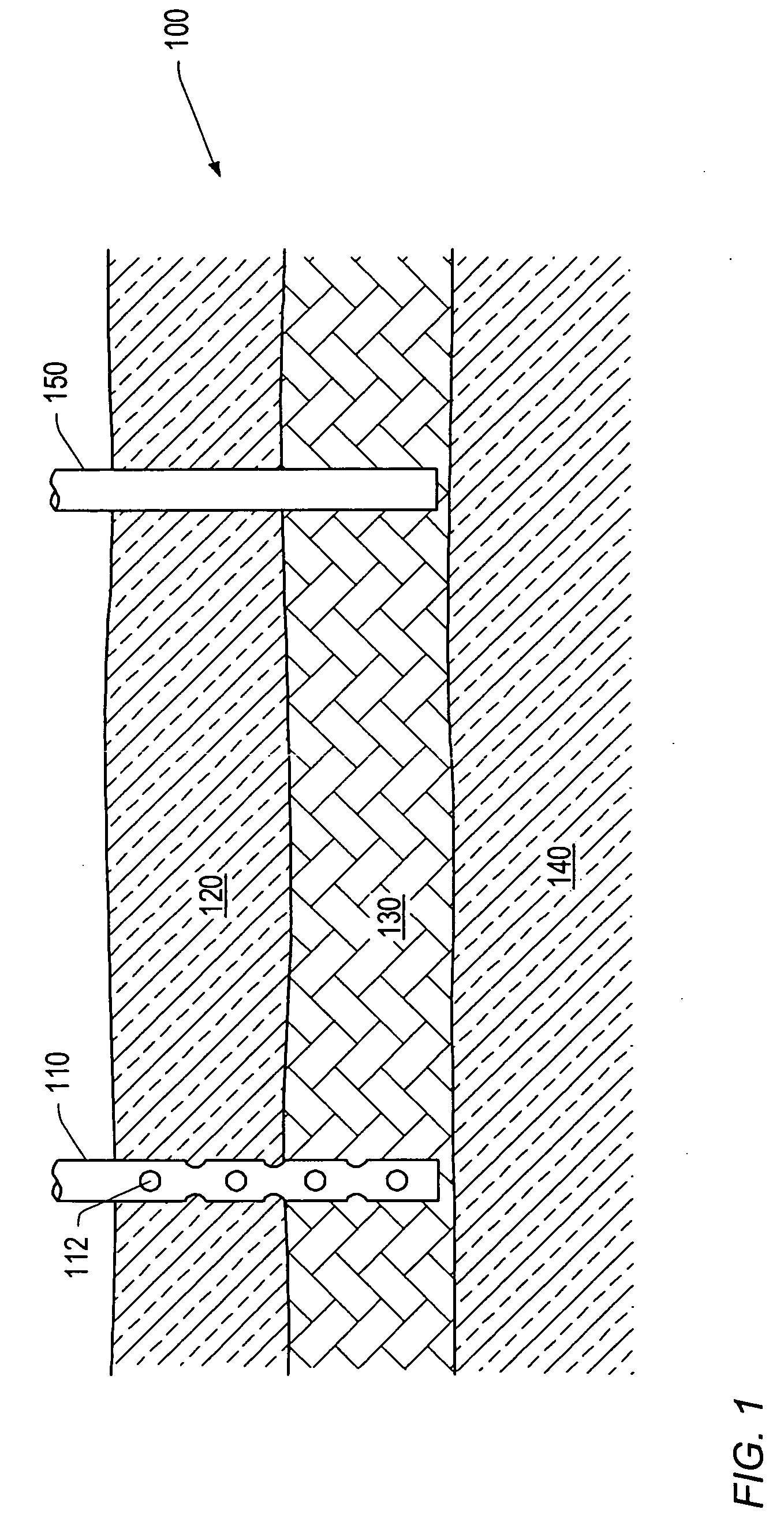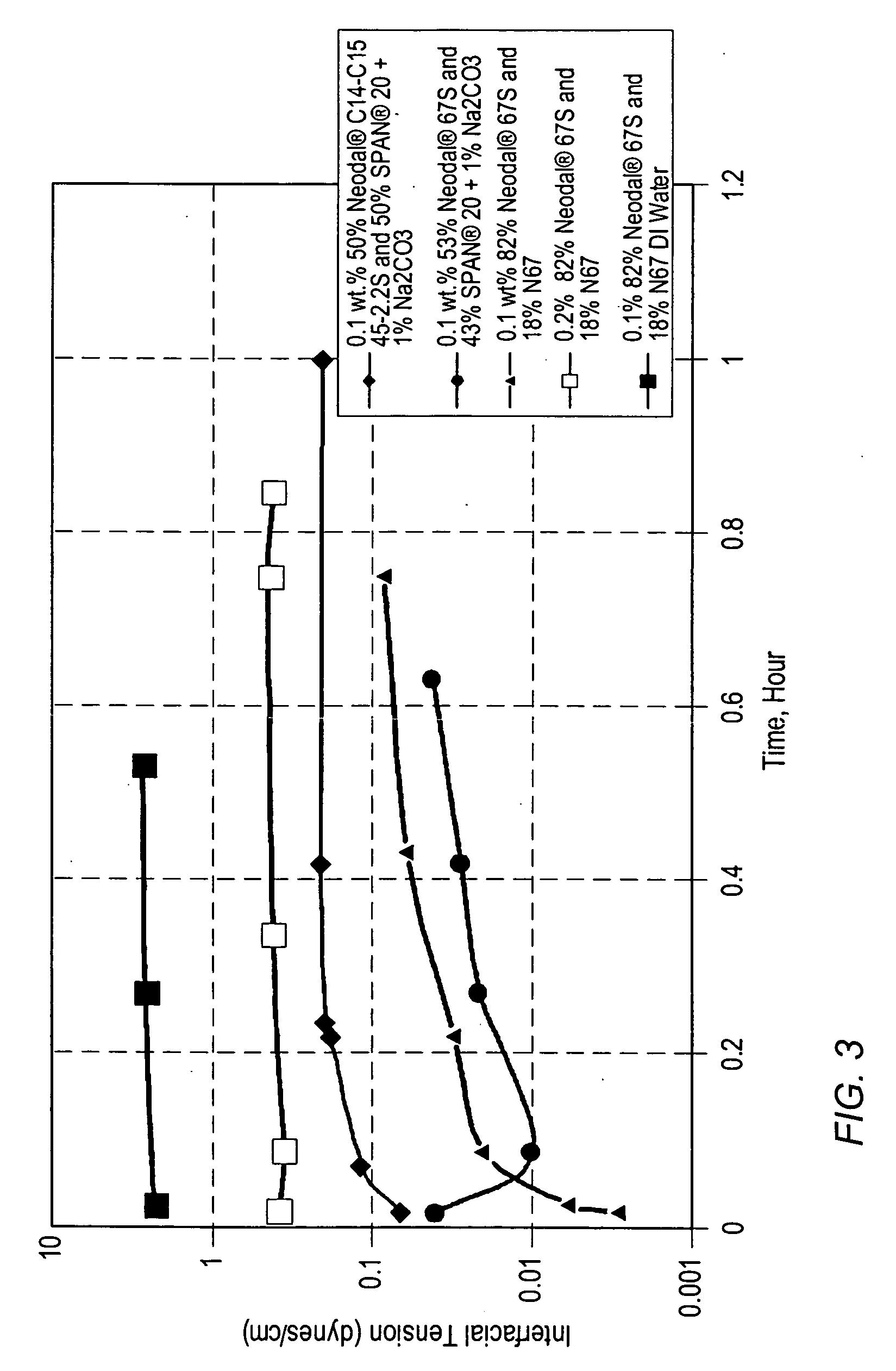Method and composition for enhanced hydrocarbons recovery
a technology of hydrocarbon recovery and composition, applied in the direction of fluid removal, chemistry apparatus and processes, borehole/well accessories, etc., can solve the problem of depletion of natural energy sources, and achieve the effect of low salinity
- Summary
- Abstract
- Description
- Claims
- Application Information
AI Technical Summary
Benefits of technology
Problems solved by technology
Method used
Image
Examples
example 1
[0075] Composition # 1 was prepared by mixing about 50 wt. % of the sodium salt of a C14 to C15 branched ethoxy sulfate (e.g., Neodol® 45-2.2S Shell Chemical Co., Houston Tex.) with 50 wt. % sorbitan laurate (e.g., SPAN® 20) at a temperature of less than about 50° C.
[0076] A polymeric column (3.8 cm×27 cm) was dry packed with about 196 mL (519.8 grams) Oklahoma # 1 sand, purged with nitrogen (7 psi) then evacuated with a vacuum. Nitrogen purging and subsequent vacuum evacuation was repeated twice. About 78 mL of Nowata crude in about 94.5 mL water was added to the column until the sand was completely saturated with hydrocarbons. The sand pack had a pore volume (PV) of about 90.73 mL, a porosity of about 32%, an absolute permeability to water of 1.1 darcy, a saturation of 1.07 volume % and an effective permeability to hydrocarbons of 1.5 darcy. About 103 mL of Nowata produced water (brine from Nowata Oil Field, Okla.) was delivered vertically from the bottom of the column to the top...
example 2
[0079] Composition #2 was prepared by mixing about 53 wt. % of the sodium salt of a C16 to C17 branched aliphatic sulfate (e.g., Neodol® 67S) from an about 20% active solution with about 47 wt % of sorbitan laurate (e.g., SPAN® 20, Aldrich Chemical Co., Milwaukee Minn.) at 25° C.
[0080] A polymeric column (3.8 cm×27 cm) was dry packed with about 193.2 mL (512 grams) Oklahoma #1 sand, purged with nitrogen (7 psi) then evacuated with a vacuum. Nitrogen purging and subsequent vacuum evacuation was repeated twice. About 80 mL of Nowata crude in about 96.9 mL water was added to the column until the sand was completely saturated with hydrocarbons. The sand pack had a pore volume (PV) of about 97.03 mL, a porosity of about 33%, an absolute permeability to water of about 1.1 darcy, saturation of about 1.03% and an effective permeability to hydrocarbons of about 1.5 darcy. About 104 mL of Nowata produced water (brine from Nowata Oil Field, Okla.) was delivered vertically from the bottom of t...
example 3
[0084] Composition #3 was prepared by mixing about 82 wt. % of a branched C16 to C17 aliphatic sulfate, sodium salt (Neodol® 67S) from an about 20% active solution with about 18 wt. % of a branched C16 to C17 aliphatic alcohol (Neodol® 67) at a temperature about 25° C.
[0085] A polymeric column (3.8 cm×27 cm) was dry packed with about 197.7 mL (524 grams) Oklahoma #1 sand, purged with nitrogen (7 psi) then evacuated with vacuum. Nitrogen purging and subsequent vacuum evacuation was repeated twice. About 80 mL of Nowata crude in about 93.2 mL water was added to the column until the sand was completely saturated with hydrocarbons. The sand pack had a pore volume of about 93.68 mL, a porosity of about 32%, an absolute permeability to water of about 1.4 darcy, saturation of 1.03% and an effective permeability to hydrocarbons of about 1.6 darcy. About 104 mL of Nowata produced water (brine from Nowata Oil Field, Okla.) was delivered vertically from the bottom of the column to the top of ...
PUM
| Property | Measurement | Unit |
|---|---|---|
| average temperature | aaaaa | aaaaa |
| carbon number | aaaaa | aaaaa |
| carbon number | aaaaa | aaaaa |
Abstract
Description
Claims
Application Information
 Login to View More
Login to View More - R&D
- Intellectual Property
- Life Sciences
- Materials
- Tech Scout
- Unparalleled Data Quality
- Higher Quality Content
- 60% Fewer Hallucinations
Browse by: Latest US Patents, China's latest patents, Technical Efficacy Thesaurus, Application Domain, Technology Topic, Popular Technical Reports.
© 2025 PatSnap. All rights reserved.Legal|Privacy policy|Modern Slavery Act Transparency Statement|Sitemap|About US| Contact US: help@patsnap.com



